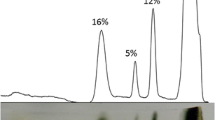Abstract
Five sulfhydryl groups of band 3, the anion-transport protein of the red blood cell membrane, can be labeled byN-ethylmaleimide (NEM). Two of these are located in a 35,000-dalton, C-terminal segment produced by chymotrypsin treatment of cells. Extensive treatment of unsealed ghosts with chymotrypsin results in the disappearance of the 35,000-dalton segment, but its two NEM-binding sites are preserved in a 9000-dalton peptide. The latter must therefore be a proteolytic product of the larger segment. Labeling of sulfhydryl groups of band 3 by an impermeant analog of NEM occurs in inside-out, but not in right-side-out vesicles derived from red cell ghosts, supporting the conclusion that NEM-reactive sulfhydryl groups, including those in the 35,000- and 9000-dalton segments, are exposed at the cytoplasmic face of the membrane. These findings support the conclusion that the 35,000-dalton segment crosses the bilayer, and suggest that the 9000-dalton segment may be a membrane-crossing portion of the 35,000-dalton segment.
Similar content being viewed by others
References
Abbott, R. E., and Schachter, D. (1976).J. Biol. Chem. 251 7176–7183.
Cabantchik, Z. I., Knauf, P. A., and Rothstein, A. (1978).Biochim. Biophys. Acta 515 239–302.
Cabantchik, Z. I., and Rothstein, A. (1974a).J. Membr. Biol. 15 207–226.
Cabantchik, Z. I., and Rothstein, A. (1974b).J. Membr. Biol. 15 227–248.
Drickamer, L. K. (1980).Ann. N.Y. Acad. Sci. 341 419–432.
DuPre, A., and Rothstein, A. (1981).Biochim. Biophys. Acta, in press.
Grinstein, S., Ship, S., and Rothstein, A. (1978).Biochim. Biophys. Acta 507 294–304.
Guidotti, G. (1972).Annu. Rev. Biochem. 41 731–752.
Guidotti, G. (1977).J. Supramol. Struct. 7 489–497.
Jennings, M. L., and Passow, H. (1979).Biochem. Biophys. Acta 554 498–519.
Laemmli, U. K. (1970).Nature 227 680–685.
Lepke, S., Fasold, H., Pring, M., and Passow, H. (1976).J. Membr. Biol. 29 147–177.
Lowry, O. H., Rosebrough, M. J., Farr, A. L., and Randall, R. J. (1951).J. Biol. Chem. 193 263–275.
Markowitz, S., and Marchesi, V. T. (1981).J. Biol. Chem., in press.
Passow, H., Fasold, H., Zaki, L., Schuhman, B., and Lepke, S. (1975). InBiomembranes: Structure and Function, G. Gardos and I. Szasz, eds., FEBS Symp., Vol. 35, North-Holland, Amsterdam, pp. 197–214.
Ramjeesingh, M., Gaarn, A., and Rothstein, A. (1980a).Biochim. Biophys. Acta 599 127–139.
Ramjeesingh, M., Grinstein, S., and Rothstein, A. (1980b).J. Membr. Biol. 57 95–102.
Ramjeesingh, M., and Rothstein, A. (1981), submitted.
Rao, A. (1979).J. Biol. Chem. 254 3503–3511.
Reithmeier, R. A. (1979).J. Biol. Chem. 254 3054–3060.
Rothstein, A. and Ramjeesingh, M. (1980).Ann. N.Y. Acad. Sci. 358 1–12.
Steck, T. L. (1974). InMethods in Membrane Biology, E. D. Korn, ed., Vol. 2, Plenum Press, New York, pp. 245–281.
Steck, T. L., and Kant, J. A. (1974).Methods Enzymol. 31 172–173.
Steck, T. L., Koziarz, J. J., Singh, M. K., Reddy, G., and Kohler, H. (1978).Biochemistry 17 1216–1222.
Steck, T. L., Ramos, R., and Strapazon, E. (1976).Biochemistry 15 1154–1161.
Swank, R. T., and Munkries, K. D. (1971).Anal. Biochem. 39 462–477.
Tanner, M. J. A., Williams, D. G., and Jenkins, R. E. (1980).Ann. N.Y. Acad. Sci. 341 455–464.
Tawney, P. O., Snyder, R. H., Canger, R. P., Leibbrand, K. A., Stiteler, C. H., and Williams, A. R. (1961).J. Org. Chem. 26 15–21.
Williams, D. G., Jenkins, R. E., and Tanner, M. J. A. (1979).Biochem. J. 181 477–493.
Author information
Authors and Affiliations
Rights and permissions
About this article
Cite this article
Ramjeesingh, M., Gaarn, A. & Rothstein, A. The sulfhydryl groups of the 35,000-dalton C-terminal segment of band 3 are located in a 9000-dalton fragment produced by chymotrypsin treatment of red cell ghosts. J Bioenerg Biomembr 13, 411–423 (1981). https://doi.org/10.1007/BF00743213
Received:
Revised:
Issue Date:
DOI: https://doi.org/10.1007/BF00743213




